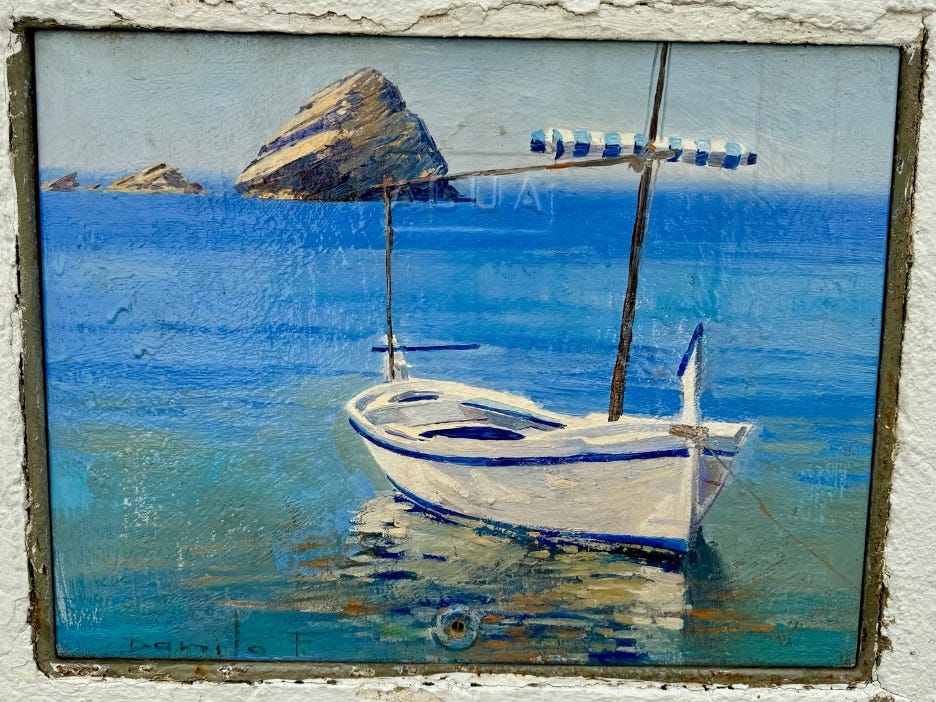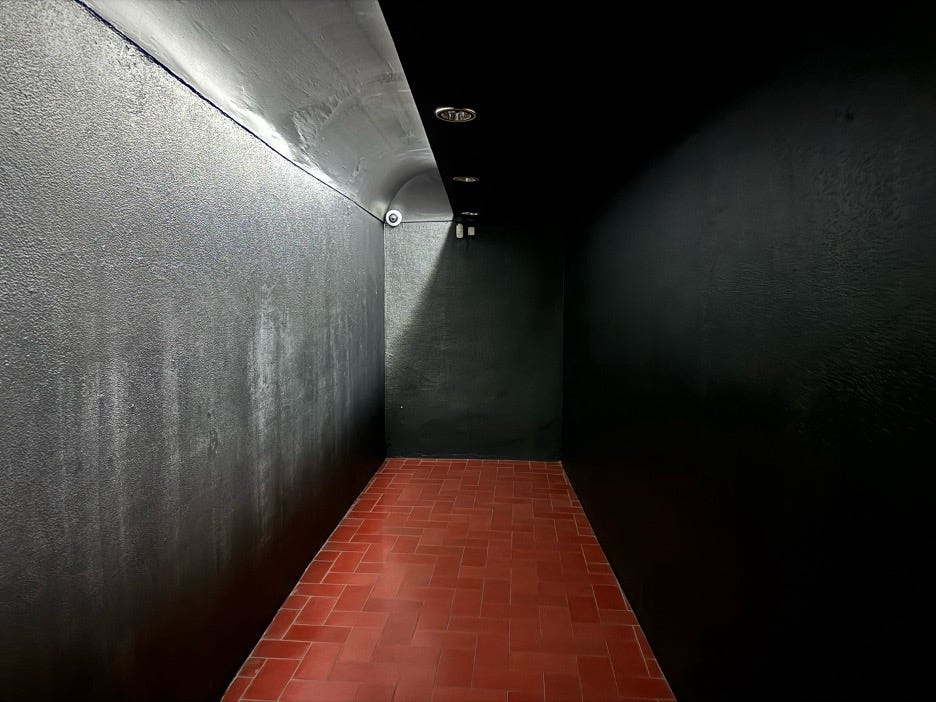Have You Ever Visited Heaven?
27 miles hiked, 3 Cultural Events Attended
There’s something about a good vacation spot where you spend a few days, and you get into the flow of the place. You rarely get lost anymore, you bump into people you’ve met there, and you start to learn the little secrets of the place. I’m sure the Germans have a 27-syllable word that describes that feeling, but whatever it is, we felt it after three days in Cadaqués.
After another great Tramuntana Hotel breakfast, we headed out for one last short walk around town. We had no itinerary other than to imprint this wonderful town deeper in our minds. Of course, I obsessively looked for more electric box art.
If the styles look familiar, they are all by the same artist, Danilo Fernandez. We saw other electric box paintings of his as well. As we were walking around looking at this wonderful public art, I wondered if the residents are commissioning the pieces or Danilo is a guerrilla street artist painting these at night, a la Banksy? No matter, taking something utilitarian, a basic electric box cover, and elevating it to art is balm for the soul.
Our goal today was a cultural tour instead of a hike. We took the long way around to get to the city of Figueres to see the Dali Theater and Museum. At best, I can almost, with some strenuous effort, muster a “meh” as a review, especially given the overcrowding (and it’s not even tourist season). Honestly, I thought the best part was the air conditioning in some rooms given the crowds and the humid day.
When Pam read what I wrote yesterday about the Dalí House, she said I better explain myself, especially since I think you should skip both the Dalí Theater and Museum if you ever visit this part of Spain. The fundamental question is: can you enjoy the art when you don’t respect the person? In my view, absolutely not. Baked into my DNA, art, politics, and life are all intertwined and one can never, ever, separate them.
During the horrific Spanish Civil War, Dalí ran away to France and America. When his friends died or were executed for fighting evil, Dalí remained ambivalent. In 1948 Dalí decided to move back to Spain and let the fascist Franco dictatorship revel and glory in his international renown. While his “art” was all over the world, gleefully supported by the fascist regime, artists with good souls in Spain were thrown in prison to rot or killed and buried in unmarked graves.
My fundamental core belief is that fascism, whether from the left or the right, is something that requires you fight against it with everything you have. I gave up a large part of my young adulthood to serve and prepare to fight fascism. Either you are against the evil of fascism, or you are evil. Life is simple.
Picasso was right. Once Dalí willingly gave his approval to fascism, we should always mention that fact every time we discuss his art. So why did we go if I have such strong feelings? Because Pam wanted to see these places. She didn’t know Dalí’s real story because the amazing marketing spin Dalí and his supporters have given to his life. I’d encourage you to read more about Dalí so you too will see that not only was he a megalomaniac asshole, but he also supported fascism. The hard truth is that I don’t view Dalí as an artist, but merely a marketer. A marketer that very successfully sold a whitewashed view of a bad soul.
I did take one interesting picture in the Dalí Theater and Museum. At the end of one hallway, there were no paintings or drawings, just black walls. I looked at this for a very long time because I imagined all the artwork by artists that were killed by the fascist Franco regime Dalí supported.
I think I would have been more amenable to both places if there was some acknowledgement that his “art” was used to glorify and to justify destroying people under the Franco fascist regime he willfully supported. At the Dalí House there’s a room covered in pictures of Dalí with famous people. The tour guide did mention “Here’s Dalí with Franco, ugh.” That was it. Everything else was glorification. It depressed the hell out of me.
After Franco died in 1975, the Pacto de Olvidado (Pack of Forgetting) became the unwritten rule in Spanish society. Understandably, people wanted to move on and join the rest of the world. After almost 50 years of ignoring the past, Spain is now starting to deal with the terrorism inflicted by both Franco, and to a smaller extent, the Republicans. I hope they continue this painful look at the past so healing can finally begin.
As I said earlier, everything in life is intertwined. If you don’t like this political discussion, feel free to unsubscribe.
After we left Figueres, we stopped at the small city of Besalú, as our guidebook said we should. (You all know Pammy the Rule Follower!) The highlights are the Monastery of Saint Peter. Founded in 977, but like any Spanish church, it grew over the centuries. During the Spanish Civil War, the interior burned so it’s disconcerting to see this huge church with nothing in it.
The town also has the stunning Besalú bridge, a Romanesque beauty with a massive iron gate in the middle. From the history the bridge was a permanent work project for many generations given all sorts of problems it had, but it’s just so awesome to look at.
A very happy surprise was that Besalú also has the partial ruins of the town synagogue. Back in Besalú’s heyday, the High Middle Ages (approx. 1,000-1,300), there was a large Jewish population. The ruins are only the foundation, but they also held the mikvah. We couldn’t see the ritual bath but were thrilled to see the emphasis put on these forgotten people.
We got to experience those heavy Spanish rains we have had on our previous walks. This time we got to stay dry, but I had to drive in them. That was some work. I should report that the manual stick drive hasn’t been a problem no matter the weather or narrowness of the road. Today I only started the car twice while forgetting to push in the clutch. Progress!
The sky was dumping when we pulled into La Rectoria de Sant Miquel de Pineda where we are staying for the next two nights. I couldn’t figure out how to park in the parking lot and a man runs out with an umbrella showing me with hand signal how he wanted me to park. I’m all confused, but we get it worked out and run through the rain inside. That’s when we met Roy, and his English wasn’t a local accent. Turns out Roy is Scottish, and his lovely wife Gorotti is Catalan. They met in Scotland where Roy was a chef and Gorotti was working to become a Scotch whisky expert and to learn English. In 2007 they found this wonderful property with a small church and a priest’s rectory and their dream of opening a B&B came to fruition. They are the most wonderful hosts and have built the kind of B&B that you dream about. I have already threatened Gorotti that we are moving in forever!
La Rectoria is a B&B&D (Bed & Breakfast & Dinner), but Thursday night is their one evening of well-earned rest. Gorotti made us dinner reservations at La Deu in the city of Olot. She said it was a very good restaurant and most importantly, given the heavy rain, we could park right in front of the entrance. That’s the kind of attention to detail that they give you at La Rectoria.
For those of you that are vegan or vegan friendly you may want to skip this paragraph. For our friend Marion in MA, close your ears! OK, only the real carnivores are left, so you are about to weep. One of the options on the menu at La Deu was veil (baby cow), which was a specialty of the restaurant. As I felt wild and crazy, I ordered it. Thinking it was going to be something like we get with a dish likeveil piccatain the US, a very thin slice of meat, I was surprised when a GIANT honking steak was set down in front of me. Then I took my first bite I now know what an out of body religious experience in heaven feels like. I was eating a steak that was a million times more tender than the best fillet mignon and had a billion times more flavor than a bone in steak. Pam rolled her eyes at my description, but the best I could come up with was in math terms, exponentiation to the exponentiation. If you remember your high school math, exponentiation is something raise to a power. For example,
Here’s how I described the flavor of the steak:
It was the best steak I have had in many decades, if not my life! I am struggling to rectify that I will most likely never eat steak again. Pam grumbled at me for licking the plate when I finished. Her grilled cod was amazing but who the hell cares about fish after the ultimate steak?
Welcome back, vegans! After the meal, we struck up a conversation with a younger couple I had recognized as staying at La Rectoria as well. Jeff and Marica were college professors (he math, she economics) at the University of Texas at Austin. They were on their first couple’s only trip after welcoming two children and are biking across Catalunya. They were a lot of fun to talk to. (Those of you who know me know how much of an introvert I am, so obviously the meal affected my brain. 😹)
After asking for my usual chupito, Jeff and Marica were curious so I explained the tradition to them and said it would be my honor to buy them their first chupitos. The staff brought out their best, but sadly, it was a weak imitation of a real aguardiente/orujo. I felt bad to introduce our new friends to the all-important Spanish chupito and it wasn’t that good. At least the thought was in the right place!
I’m sorry this installment of our gripping saga is a day late. The wine and chupitos caught up with me and I fell asleep writing. I thought about sending out what my forehead typed when I was drooling on the keyboard, but asdhjfuiohsdf voaheirwueiehflkna REDRUM dweOIR REDRUM OQEWR didn’t make much sense.
Thank you for being on this adventure with us!







Like most people I was not familiar with Dali's background. Picasso's "Guernica," on the other hand, is very moving and a must-see when you visit Madrid.
Thank you for giving us the political background of Dali. I like to know who the cowards who sold out are.